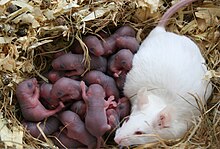
Hamsters are rodents belonging to the subfamily Cricetinae, which contains 19 species classified in seven genera. They have become established as popular small pets. The best-known species of hamster is the golden or Syrian hamster, which is the type most commonly kept as a pet. Other hamster species commonly kept as pets are the three species of dwarf hamster, Campbell's dwarf hamster, the winter white dwarf hamster and the Roborovski hamster.
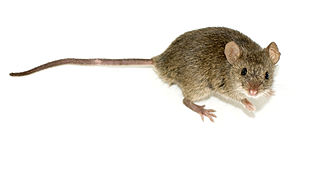
A mouse is a small rodent. Characteristically, mice are known to have a pointed snout, small rounded ears, a body-length scaly tail, and a high breeding rate. The best known mouse species is the common house mouse. Mice are also popular as pets. In some places, certain kinds of field mice are locally common. They are known to invade homes for food and shelter.

The fancy rat is the domesticated form of Rattus norvegicus, the brown rat, and the most common species of rat kept as a pet. The name fancy rat derives from the use of the adjective fancy for a hobby, also seen in "animal fancy", a hobby involving the appreciation, promotion, or breeding of pet or domestic animals. The offspring of wild-caught specimens, having become docile after having been bred for many generations, fall under the fancy type.

The common degu, or, historically, the degu, is a small hystricomorpha rodent endemic to the Chilean matorral ecoregion of central Chile. The name degu on its own indicates either the entire genus Octodon or, more commonly, just the common degu. Common degus belong to the parvorder Caviomorpha of the infraorder Hystricognathi, along with the chinchilla and guinea pig. The word degu comes from the indigenous language of Chile, Mapudungun, and the word dewü, meaning 'mouse' or 'rat'.

Jack Black was a rat-catcher and mole destroyer from Battersea, England during the middle of the 19th century. Black cut a striking figure in his self-made "uniform" of a green topcoat, scarlet waistcoat, and breeches, with a huge leather sash inset with cast-iron rats. Black promoted himself as the Queen's official rat-catcher, but he never held a royal warrant.
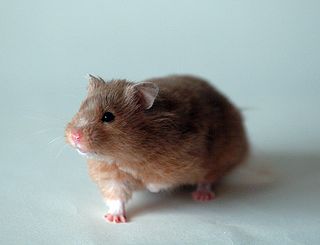
The golden hamster or Syrian hamster is a rodent belonging to the hamster subfamily, Cricetinae. Their natural geographical range is in an arid region of northern Syria and southern Turkey. Their numbers have been declining in the wild due to a loss of habitat from agriculture and deliberate elimination by humans. Thus, wild golden hamsters are now considered endangered by the International Union for Conservation of Nature. However, captive breeding programs are well established, and captive-bred golden hamsters are often kept as small house pets. They are also used as scientific research animals.

The house mouse is a small mammal of the order Rodentia, characteristically having a pointed snout, large rounded ears, and a long and almost hairless tail. It is one of the most abundant species of the genus Mus. Although a wild animal, the house mouse has benefited significantly from associating with human habitation to the point that truly wild populations are significantly less common than the semi-tame populations near human activity.

The laboratory mouse or lab mouse is a small mammal of the order Rodentia which is bred and used for scientific research or feeders for certain pets. Laboratory mice are usually of the species Mus musculus. They are the most commonly used mammalian research model and are used for research in genetics, physiology, psychology, medicine and other scientific disciplines. Mice belong to the Euarchontoglires clade, which includes humans. This close relationship, the associated high homology with humans, their ease of maintenance and handling, and their high reproduction rate, make mice particularly suitable models for human-oriented research. The laboratory mouse genome has been sequenced and many mouse genes have human homologues. Lab mice are sold at pet stores for snake food and can also be kept as pets.
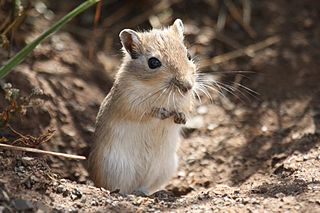
The Mongolian gerbil or Mongolian jird is a rodent belonging to the subfamily Gerbillinae. Their body size is typically 110–135 mm, with a 95–120 mm tail, and body weight 60–130 g, with adult males larger than females. The animal is used in science and research or kept as a small house pet. Their use in science dates back to the latter half of the 19th century, but they only started to be kept as pets in the English-speaking world after 1954, when they were brought to the United States. However, their use in scientific research has fallen out of favor.
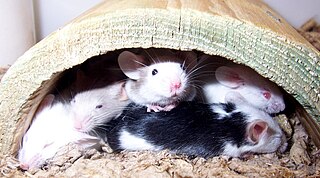
The most common rodents kept as household pets are hamsters, gerbils, common degus, fancy mice, fancy rats, common chinchillas, and guinea pigs (cavies).
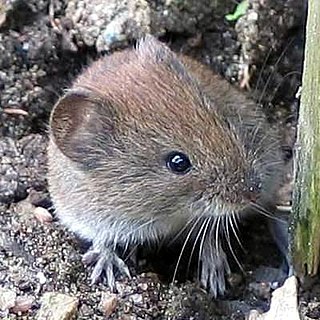
The bank vole is a small vole with red-brown fur and some grey patches, with a tail about half as long as its body. A rodent, it lives in woodland areas and is around 100 millimetres (3.9 in) in length. The bank vole is found in much of Europe and in northwestern Asia. It is native to Great Britain but not to Ireland, where it has been accidentally introduced, and has now colonised much of the south and southwest.

The term spiny mouse refers to any species of rodent within the genus Acomys. Similar in appearance to mice of the genus Mus, spiny mice are small mammals with bare tails which contain osteoderms, a rare feature in mammals. Their coats are endowed with unusually stiff guard hairs similar to the spines of a hedgehog; this trait is the source of the common name, spiny mouse.

Peromyscus maniculatus is a rodent native to eastern North America. It is most commonly called the eastern deer mouse; when formerly grouped with the western deer mouse, it was referred to as the North American deermouse and is fairly widespread across most of North America east of the Mississippi River, with the major exception being the lowland southeastern United States.

A hamster wheel or running wheel is an exercise device used primarily by hamsters and other rodents, but also by other cursorial animals when given the opportunity. Most of these devices consist of a runged or ridged wheel held on a stand by a single or pair of stub axles. Hamster wheels allow rodents to run even when their space is confined. The earliest dated use of the term "hamster wheel", located by the Oxford English Dictionary, is in a 1949 newspaper advertisement.
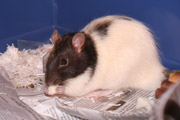
The American Fancy Rat and Mouse Association (AFRMA), formed in 1983, is a California-based club of rodent enthusiasts that organizes shows, establishes breed standards, and promotes both the fancy rat and the fancy mouse as appealing pets. Their scope and intent is similar to the American Kennel Club in its association with dogs.
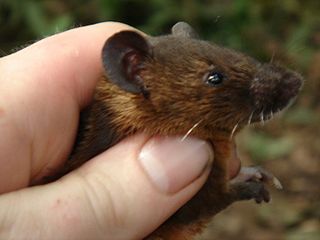
The rusty-bellied brush-furred rat is a species of rodent in the family Muridae. It is found in Angola, Benin, Cameroon, Central African Republic, Republic of the Congo, Democratic Republic of the Congo, Ivory Coast, Equatorial Guinea, Gabon, Ghana, Guinea, Kenya, Liberia, Nigeria, Sierra Leone, Tanzania, Togo, and Uganda. Its natural habitats are subtropical or tropical moist lowland forests, subtropical or tropical seasonally wet or flooded lowland grassland, arable land, and pastureland.

The Down Under rat is a fancy rat variety noted for the markings on its stomach. The "downunder" marking refers to both a patch of colour on the underside of the rat which matches the coat colouring on the top, and to the variety's Australian origins.

Rodents are mammals of the order Rodentia, which are characterized by a single pair of continuously growing incisors in each of the upper and lower jaws. About 40% of all mammal species are rodents. They are native to all major land masses except for New Zealand, Antarctica, and several oceanic islands, though they have subsequently been introduced to most of these land masses by human activity.
Colours of the Syrian hamster can be described in three ways: as "self", "agouti" or "combinations". Self colours are a consistent coat colour with the same colour topcoat and undercoat. Agouti hamsters have a ticked coat, where each individual fur is banded in different colours. Agouti hamsters also have "agouti markings" which consist of dark cheek markings, a dark marking on the head, and a light underbelly. Combinations are produced when two self or agouti colours are present.

Abbie E. C. Lathrop was a rodent fancier and commercial breeder who bred fancy mice and inbred strains for animal models, particularly for research on development and hereditary properties of cancer.

